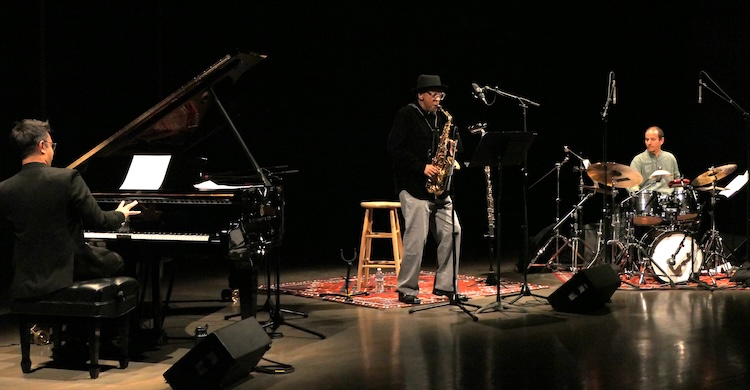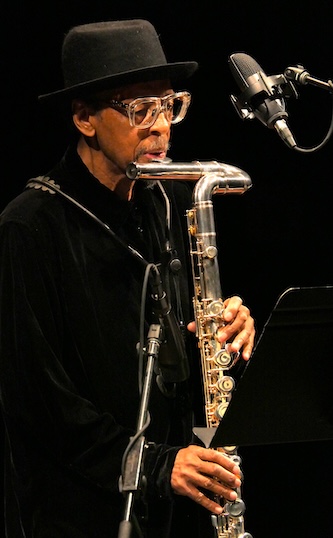Jazz Concert Review: A Moody and Skeletal Evening from a Select Trio
By Paul Robicheau
A unique, memorable summit of three intellectually minded luminaries who bridged jazz, classical, Latin and South Asian influences.

l to r: Vijay Iyer, Henry Threadgill, and Dafnis Prieto trio at Institute for Contemporary Art. Photo: Paul Robicheau
The last time that saxophonist/composer Henry Threadgill played Boston, his daughter was born. She’s now 28. The fact that the 2018 Pulitzer winner was onstage at the Institute of Contemporary Art after a local absence of nearly three decades made Saturday’s concert worth celebrating by itself. Yet the 81-year-old Threadgill was part of his rare trio with likewise-lauded pianist Vijay Iyer (whose own trio albums grace critics lists) and Cuban-born drummer Dafnis Prieto, both past MacArthur Foundation “genius grant” recipients.

Henry Threadgill at at the ICA. Photo: Paul Robicheau
The format was simple. The three musicians took turns playing each other’s compositions, following sheet music while improvising outside the lines. And their 70-minute concert in the ICA’s sold-out Barbara Lee Family Foundation Theatre often proved moody and skeletal (the musicians sensing different parts of each puzzle they could fill), if more openly engaging by the end.
Operating without a bass player in the group, Iyer favored the low end of his piano, anchoring the direction of the piece with pondered precision through dark chords and spaced notes. Prieto shadowed with sparse rhythms and Threadgill began with whispery tones on the horizon top of a bass flute shaped like a T, its mostly vertical form resting on a endpin like a cello. Threadgill became more assertive a few pieces in, such as during Iyer’s “I Wanted a Map/This is a Map,” switching to alto sax, where he slapped fingers into trills and hit split-tone highs before the tune resolved back to its creeping refrain and tempo.
The set grew more intriguing in the pianist’s “Discount Megamall,” where he laid his right hand flat against the keys while tweaking sporadic notes. Prieto brought mallets to his cymbals and plastic block, then swung with swirling brushes while Threadgill injected a musing, mournful melody. Iyer eventually slipped into quiet, cascading runs down his keyboard, evoking raindrops. The trio picked up speed as it dropped into Threadgill’s “Where Coconuts Fall,” the dominant fulcrum of piano and percussion building stormy crescendos while the saxophonist smiled and slowly tapped his foot before entering with some intense alto statements when not nodding at his bandmates’ flanking clamor.

Dafnis Prieto at the ICA. Photo: Paul Robicheau
Prieto, while the least widely known member of the group, generated many of its sparks. After another contemplative passage graced by Threadgill’s bass flute, Prieto’s “On the Way” closed the night with authority. Iyer tapped inside his piano with his left hand, offset by staccato notes with his right, and the drummer churned around his kit with rimshots and accents to his block and bell cymbal, creating a dance-savvy feel capped by Threadgill’s jaunty alto work. Prieto then launched into an enthralling solo that added a punchy kick drum and toms to his other toys (which included a frying pan), bringing a compositional sense even to his drum patterns. The short set could have used an encore (Iyer placed a piece of fresh sheet music at his piano seemingly just in case), but they were on the way to calling it a night with a worthy finish.
Threadgill, once hailed by the New York Times as “perhaps the most important jazz composer of his generation,” wasn’t as in command in this setting as past projects from the 1970s free-jazz trio Air to the unusual Very Very Circus and Zooid. But the unique summit of three intellectually minded luminaries who bridged jazz, classical, Latin and South Asian influences still made it a night to remember.
Paul Robicheau served more than 20 years as contributing editor for music at the Improper Bostonian in addition to writing and photography for the Boston Globe, Rolling Stone, and many other publications. He was also the founding arts editor of Boston Metro.
Tagged: Dafnis Prieto, Henry Threadgill, Institute for Contemporary Art

Sorry I couldn’t make this gig, glad that Paul Robicheau documented it.